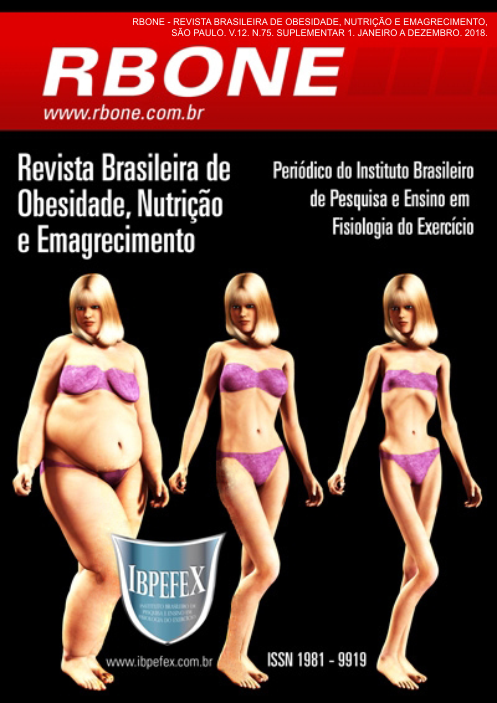Interference of the responsible for the preparation of meals in the adhesion to the nutritional treatment of diabetics attended in a nutrition clinic
Abstract
Introduction and Objective: Diabetic patients have difficulty following treatment and adhere to nutritional guidelines and this article, was to evaluate the adherence to the diet and lifestyle of patients with diabetes treated at the Nutrition Outpatient Clinic, and its relationship with the place where the meals are eaten Responsible for the preparation of their food. Materials and methods: An evaluation made by the secondary data of patients' medical records: socioeconomic, anthropometric data and life habits. We calculated a percentage of weight variation and loss of excess weight, and it was to evaluated in an association of all data with the place of meals and with the person in charge of preparation. Discussion: Among other factors, adherence to the guidelines depend on the location and preparation for the meal. Results: The place where meals were performed was only associated with the age groups, and those responsible for the preparation of meals were only associated with gender, consumption of integrals and percentage of loss of excess weight. Conclusion: That the responsible for the preparation of the meals was related with good adhesion of the diabetic patients.
References
-Almeida, D.K.S.; Chagas, D.C. Fatores associados à adesão ao aconselhamento Nutricional de indivíduos com excesso de peso atendidos em unidades Básicas de saúde no município de São Luis-MA. Revista de Enfermagem. Vol. 47. 2016. p. 1-48.
-Alves, B.A; Calixto, A.A.T.F. Aspectos determinantes da adesão ao tratamento de hipertensão e diabetes em uma Unidade Básica de Saúde do interior paulista. Journal of Health Sciences Institute. Vol. 30. Num. 3. 2012. p. 255-260.
-Bezerra, I.N.; Souza, A.M.; Pereira, R.A.; Sichieri, R. Consumo de alimentos fora do domicílio no Brasil. Revista de Saúde Pública. Vol. 47. 2013. p. 200-211.
-Corrêa, K., Gouvêa, G.R.; Silva, M.A.V.; Possobon, R.F.; Barbosa, L.F.L.N.; Pereira A.C. Quality of life and characteristics of diabetic patients. Ciência & Saúde Coletiva. Vol. 22. Num. 3. 2017. p. 921-930.
-Goldenberg, P.; Franco, L.J.; Pagliaro, H.; Silva, R.S.; Santos, C.A. Diabetes mellitus auto-referido no município de São Paulo: prevalência e desigualdade. Caderno de Saúde Pública. Vol. 12. Num. 1. 1996. p. 37-45.
-Guimarães, M.G.; Dutra, E.S.; Ito, M.K.; Carvalho, K.M.B. Adesão a um programa de aconselhamento nutricional para adultos com excesso de peso e comorbidades. Revista de Nutrição. Vol. 23. Num. 3. 2010. p. 323-333.
-International Diabetes Federation. Diabetes Atlas da IDF 2015. Vol. 7. 2016. p. 48-144.
-Instituto Brasileiro de Geografia e Estatística. Pesquisa de Orçamento Famíliar (POF): 2008-2009: Análise do consumo alimentar pessoal no Brasil. Rio de Janeiro. 2011.
-Linck, C.L.; Bielemann, V.L.M.; Sousa, A.S.; Lange, C. Paciente crônico frente ao adoecer e a aderência ao tratamento. Acta Paul Enfermagem Vol. 21. Num. 2. 2008. p. 317-222.
-Lipschitz, D.A. Screening fornutritional status in the elderly. Primary Care. Philadelphia. Vol. 21. Num. 1. 1994. p. 55-67.
-Ministério da Saúde. Secretaria de Vigilância em Saúde. Vigitel Brasil 2015. Vigilância de Fatores de Risco e Proteção para Doenças Crônicas por Inquérito Telefônico. (Série G. Estatística e In¬formação em Saúde). Brasília. 2015.
-Organização Mundial da Saúde. Classificação mundial de medida da circunferência abdominal. Geneva. 2010.
-Pitanga, F.J.G.; Lessa, I. Indicadores antropométricos de obesidade como instrumento de triagem para risco coronariano elevado em adultos na cidade de Salvador -Bahia. Arquivos Brasileiros de Cardiologia. Vol. 51. Num. 8. 2005. p. 26-31.
-Silva, R.K.; Junior, A.M. Avaliação da adesão ao tratamento e controle do diabetes Mellitus na atenção primária à saúde. Revista da Escola de Enfermagem da USP. Vol. 48. Num. 2. 2016. p. 1-6.
-Sociedade Brasileira de Diabetes. Diretrizes da Sociedade Brasileira de Diabetes: 2015-2016; Sociedade Brasileira de Diabetes. 2016.
-Valdez, R.A. Simple model-based index of abdominal. Adiposity. Journal of Clinical Epidemiology. Vol. 44. Num. 9. 1991. p. 955-956.
-World Health Organizarion (WHO). Expert Committee Physical status: the use and interpretation of antrophometry. Geneva. 1995.
Authors who publish in this journal agree to the following terms:
- Authors retain the copyright and grant the journal the right of first publication, with work simultaneously licensed under the Creative Commons Attribution License BY-NC which allows the sharing of the work with acknowledgment of the authorship of the work and initial publication in this journal.
- Authors are authorized to enter into additional contracts separately for non-exclusive distribution of the version of the work published in this journal (eg, publishing in institutional repository or book chapter), with acknowledgment of authorship and initial publication in this journal.
- Authors are allowed and encouraged to post and distribute their work online (eg, in institutional repositories or on their personal page) at any point before or during the editorial process, as this can bring about productive change as well as increase impact and impact. citation of published work (See The Effect of Free Access).






